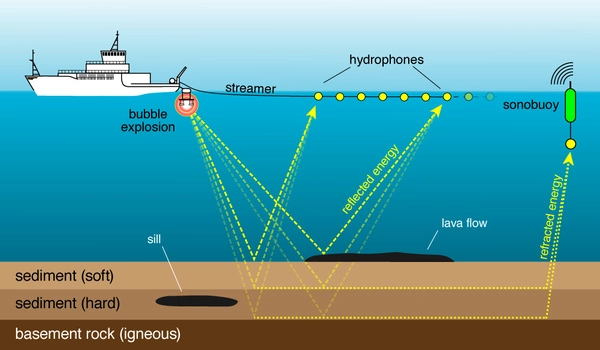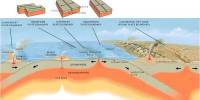Signal processing is typically used to separate signals recorded at the seafloor, especially in the context of marine acoustics or seismology. The goal is to extract useful information from recorded signals while reducing noise and interference.
According to new research, pyrite sulfur isotope variations may not represent the global processes that have made them such popular targets for analysis and interpretation. A new microanalysis method aids in the separation of signals that reveal the relative influence of microbes and local climate.
Plate tectonics is to blame. The deep ocean is never preserved, but rather lost to time as the seafloor subducts. To inform their studies of Earth history, geologists are mostly left with shallower rocks from closer to the shoreline.
“We only have a good record of the deep ocean for the last 180 million years,” said David Fike, the Glassberg/Greensfelder Distinguished University Professor of Earth, Environmental, and Planetary Sciences at Washington University in St. Louis. “The rest is just shallow-water deposits.” So it’s critical to understand the bias that may exist when looking at shallow-water deposits.”
We only have a good record of the deep ocean for the last 180 million years. The rest is just shallow-water deposits. So it’s critical to understand the bias that may exist when looking at shallow-water deposits.
David Fike
Scientists, such as Fike, use seafloor deposits to reconstruct timelines of past ecological and environmental change. Researchers are eager to learn how and when oxygen began to accumulate in the oceans and atmosphere, making Earth more hospitable to life as we know it.
They have relied on pyrite, the iron-sulfide mineral known as “fool’s gold,” for decades as a sensitive recorder of conditions in the marine environment where it is formed. Scientists have attempted to better understand ancient microbial activity and interpret global chemical cycles by measuring the bulk isotopic composition of sulfur in pyrite samples (the relative abundance of sulfur atoms with slightly different masses).
However, the outlook for pyrite is no longer so bright. Fike and his colleagues show in a pair of companion papers published Nov. 24 in the journal Science that variations in pyrite sulfur isotopes may not represent the global processes that have made them such popular targets of analysis.
Instead, Fike’s research shows that pyrite responds primarily to local processes that should not be interpreted as representative of the entire ocean. The researchers were able to separate signals in pyrite that revealed the relative influence of microbes and local climate thanks to a new microanalysis approach developed at Washington University.

Fike collaborated with Roger Bryant, who recently completed his graduate studies at Washington University, on the first study, which looked at the grain-level distribution of pyrite sulfur isotope compositions in a sample of recent glacial-interglacial sediments. They created and applied a cutting-edge analytical technique in Fike’s laboratory using a secondary-ion mass spectrometer (SIMS).
“We analyzed every individual pyrite crystal that we could find and got isotopic values for each one,” Fike went on to say. By looking at the distribution of results from individual grains rather than the average (or bulk) results, the scientists demonstrated that it is possible to separate the role of physical depositional environment properties like sedimentation rate and porosity from microbial activity on the seafloor.
“We found that even when bulk pyrite sulfur isotopes changed a lot between glacials and interglacials, the minima of our single grain pyrite distributions remained broadly constant,” Bryant said. “This told us that microbial activity did not drive the changes in bulk pyrite sulfur isotopes and refuted one of our major hypotheses.”
“Using this framework, we’re able to go in and look at the separate roles of microbes and sediments in driving the signals,” Fike said. “That to me represents a huge step forward in being able to interpret what is recorded in these signals.”
In the second paper, led by Itay Halevy of the Weizmann Institute of Science and co-authored by Fike and Bryant, the scientists developed and explored a computer model of marine sediments, complete with mathematical representations of the microorganisms that degrade organic matter and turn sulfate into sulfide and the processes that trap that sulfide in pyrite.
“We found that variations in the isotopic composition of pyrite are mostly a function of the depositional environment in which the pyrite formed,” Halevy said. The new model shows that a range of parameters of the sedimentary environment affect the balance between sulfate and sulfide consumption and resupply, and that this balance is the major determinant of the sulfur isotope composition of pyrite.
“The rate of sediment deposition on the seafloor, the proportion of organic matter in that sediment, the proportion of reactive iron particles, the density of packing of the sediment as it settles to the seafloor – all of these properties affect the isotopic composition of pyrite in ways that we can now understand,” he added.
Importantly, none of these sedimentary environment properties are strongly linked to the global sulfur cycle, the oxidation state of the global ocean, or essentially any other property that researchers have traditionally used pyrite sulfur isotopes to reconstruct, according to the scientists.
















